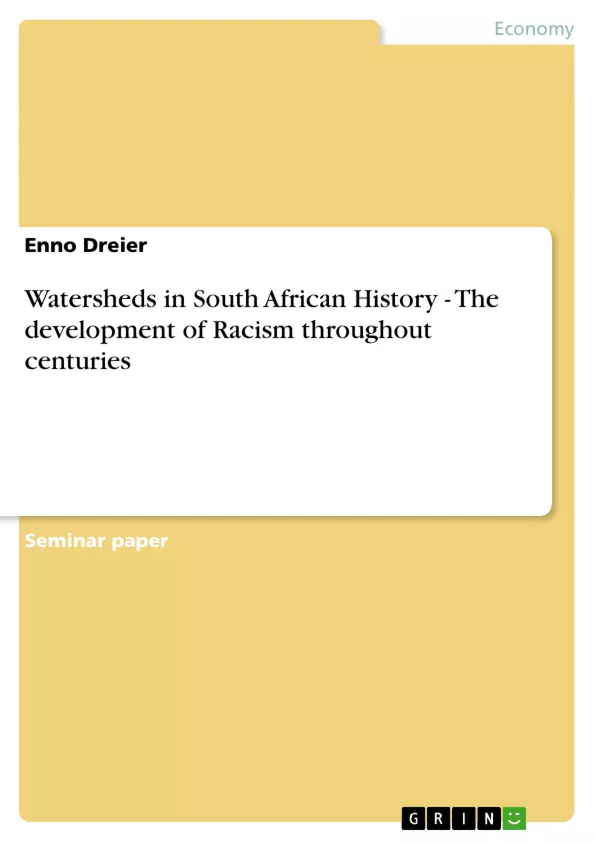Drop a frog into boiling or near boiling water. He jumps out. Then put one in cold water with a slow flame. He likes the warmth. He gets comfortable and sleepy. He eventually gets cooked.
History is often seen as pre-determined. Developments occur rather slowly so that, like a frog in warm water, it might not be possible to see what is happening in the long run.
The following text will deal with the question of possible turning points in South African racism history. It will try to figure out when things could have changed in another, possibly better way, and what events prevented that from happening. It will therefore describe the colonisation by the mainly Dutch-speaking Boers in the 17 th and 18 th century and the early relations between colonialists and indigenous population with special reference to the creeping development of racist attitudes. In the second part the systemic period of British colonialism will be investigated. The introduction of a capitalistic system and the influences of the Evangelist Humanitarian Movement will be described first. In the second part the impacts of British capitalism and the discovery of gold and diamonds will be major topics to be analyzed with respects to a development of a racist ideology. Thirdly I will describe the rise of Afrikaner Nationalism mainly in the first five decades of the 20 th century and what root causes underlie this development.
The main questions I will deal with are:
• Was the development of South African racism unavoidable?
• Why did racism develop?
• When had been crucial points in history that could made a different development possible?
Inhaltsverzeichnis (Table of Contents)
- Introduction.
- Terminology...
- The Pre-British Era
- Started in 1652 the Dutch Colony was never an official colony but corporate property of the Dutch East India Company (VOC).
- Since the beginning of the settlement there was a lack of labour force in the Cape.
- In the first decades of farming the white farmers were dependent on the Khoikhoi and their farming knowledge.
- Due to the steady lack of labour forces on the frontier and the high prices of slaves the system of inboekelinge was invented at the end of the 17th century.
- Also very important for the development of economy and society was the establishment of the commando system in order to fight the "wild" Khoikhoi and the San.
- British Colonialism until 1948..
- British rule and Evangelist humanitarian movement
- The discovery of Diamonds and Gold.
- Afrikaner Nationalism.
- Conflicts of the 1920s.
- The Great Depression and World War II...
- The Elections of 1948.
- First Years of Apartheid.....
- Conclusion..
Zielsetzung und Themenschwerpunkte (Objectives and Key Themes)
This text aims to explore possible turning points in South African racism history, identifying moments when alternative, potentially more positive paths could have been taken. It analyzes the development of racist attitudes within the context of Dutch and British colonialism, focusing on the evolving relationship between colonizers and the indigenous population. The text examines the impact of economic factors, such as the discovery of diamonds and gold, on the development of racist ideology.
- The emergence and evolution of racism in South African history
- The role of colonialism and economic factors in shaping racist attitudes
- The impact of different historical events on the development of racism
- The significance of labor practices and social structures in perpetuating racial inequality
- The rise of Afrikaner nationalism and its roots in historical events
Zusammenfassung der Kapitel (Chapter Summaries)
The introduction sets the stage for the analysis, using the analogy of a frog in warm water to illustrate the gradual, often unnoticed development of racism. It outlines the text's goal of identifying potential turning points in South African history.
The chapter on terminology defines key terms like "Afrikaners," "Boers," "Whites," and "Blacks," as used in the text. It also discusses two contrasting definitions of racism: the older definition of intrinsic racial superiority and the newer definition of discriminatory behavior.
The chapter on the pre-British era examines the Dutch colony's establishment and its economic and social development. It explores the interaction between the Dutch settlers and the indigenous Khoikhoi and San populations, focusing on the emerging practice of enslavement, the use of forced labor, and the emergence of racist attitudes.
Schlüsselwörter (Keywords)
This text focuses on the historical development of racism in South Africa, exploring the impact of colonialism, economic factors, labor practices, and social structures. Key themes include Dutch colonialism, British colonialism, Afrikaner nationalism, the discovery of diamonds and gold, the exploitation of indigenous populations, the development of racist attitudes, and the use of forced labor.
- Quote paper
- Enno Dreier (Author), 2003, Watersheds in South African History - The development of Racism throughout centuries, Munich, GRIN Verlag, https://www.grin.com/document/21454



